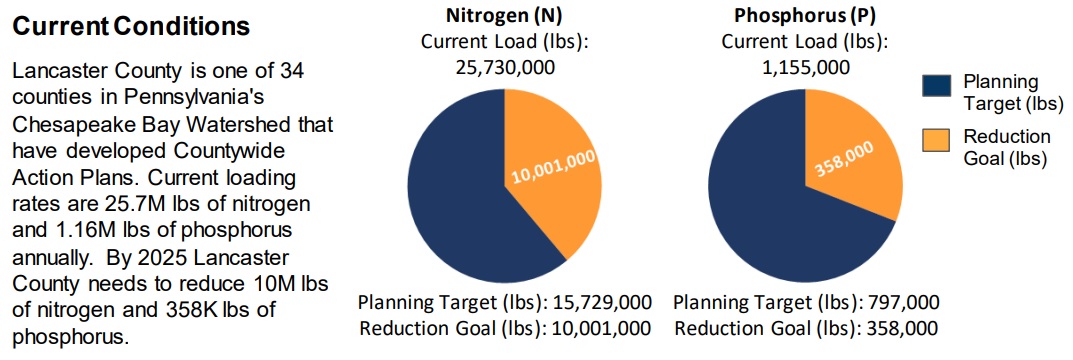The State of the Bay: How is Lancaster doing with our clean water goals?
Hourglass Lancaster
This article ran in the Spring 2022 issue of Hourglass Quarterly. View the full publication here.
In 2010 the Environmental Protection Agency (EPA) mandated the six Chesapeake Bay states, including Pennsylvania, and the District of Columbia develop plans to reduce pollution to the Bay by 2025. This effort, known as Chesapeake Bay Total Maximum Daily Load (TMDL), included pollution limits for nitrogen, phosphorus and sediment, and milestones to achieve those reductions. The EPA also included additional restrictions and mandates if not achieved.
So with less than four years remaining, what is the progress and what does this mean for Lancaster County?
The State of the Blueprint
According to the Chesapeake Bay Foundation’s recently released “2021 State of the Blueprint” report, if progress continues at its current pace, the Bay partnership will not achieve the required pollution reduction by 2025. Maryland, Pennsylvania and Virginia account for roughly 90% of the Bay’s pollution, and while Maryland and Virginia are mostly on-track to meet their commitments per the report, Pennsylvania is lagging behind. From 2009 to 2020, watershed states reduced the amount of nitrogen reaching the Bay by 40%, leaving 60% of the work to be accomplished in five years.
Pennsylvania’s Challenges & Successes
Much of the shortfall is in Pennsylvania, largely because the great majority of nutrient and sediment runoff comes from the 33,000 farms and increasingly developed areas in Pennsylvania’s portion of the Bay drainage. According to the Bay models, all states have struggled to control farm runoff. Pennsylvania developed a Watershed Implementation Plan (WIP) to address the reductions they need to achieve.
In the TMDL, Pennsylvania is required to reduce nitrogen loads by 32.5 million pounds and phosphorus by 0.85 million pounds. As of 2020, Pennsylvania has reduced nitrogen pollution by 6.77 million pounds and phosphorus pollution by 0.3 million pounds.
According to the Chesapeake Bay Foundation, more than 90% of Pennsylvania’s remaining pollution reductions must come from agriculture. While farmers are adopting conservation practices and eager to do their part for clean water, a massive influx of technical and financial assistance is still required to provide the resources to put these practices in place at the scale and pace necessary.
Across the watershed, the wastewater sector remains the one area of noteworthy success. However, the loss of farms and forests to development, coupled with more severe storms linked to climate change, pose new challenges for stemming rising pollution from urban and suburban runoff.
In January the Pennsylvania Department of Environmental Protection updated Pennsylvania’s Watershed Implementation Plan (WIP) to outline how the state will meet its 2025 targets. Yet funding remains a significant challenge. As proposed, the plan estimates the need for $521 million a year until 2025 for implementation. However, compared to existing resources, there is a shortfall in funding of nearly $324 million a year. Although the plan contains several proposed funding sources, none of them have been passed by the legislature.
Local Solutions: Lancaster County a Key Component
Lancaster County is responsible for 21% of Pennsylvania’s total reduction goals. The Lancaster Countywide Action Plan, managed by the Lancaster Clean Water Partners and the Lancaster County Conservation District, outlines Lancaster’s path for reducing 11.7 million lbs. of nitrogen and 524,000 lbs. of phosphorus by the 2025 deadline. The Lancaster Clean Water Partners, and countless community members, have shown incredible leadership in collaborating and implementing on-the-ground solutions to provide clean and clear water for our community.
Lancaster’s Plan centers around four initiatives:
- Agriculture
- Stormwater
- Riparian buffers
- and Data management and monitoring

A Focus on Agriculture
Lancaster County expects to reduce 7,195,000 pounds of nitrogen from the agriculture sector, representing more than 99% of the total nitrogen Lancaster expects to reduce by 2025.
Some of the focus areas in Lancaster’s agriculture sector have been working with farmers to establish soil conservation and water quality plans, helping farmers implement practices such as cover cropping and reduced tillage that prevent erosion, and building manure storage facilities. Approximately 50% of Lancaster County farms now have conservation plans.
An example of collaborative efforts having a positive impact on these goals, the Lancaster Farmland Trust successfully launched a program linking preservation and conservation efforts across the county. This program offered funding to fast-track farmers on the preservation waiting list who opted to install conservation practices simultaneously. Leveraging $490,000 from National Fish and Wildlife Foundation, Lancaster Farmland Trust preserved five Lancaster farms and completed conservation practices on those properties. Combined, those improvements will lead to the prevention of 13,703 lbs. of nitrogen, 1,176 lbs. of phosphorus and 572,338 lbs. of sediment from flowing into the Chesapeake Bay every year.
Lancaster’s plan also calls for planting and maintaining 1000 new acres of riparian buffer every year until 2025. In the spring and fall of 2021, technical service providers planted 120 acres of new buffers. According to the September 2021 edition of the Lancaster Countywide Action Plan, “there is still unmet demand from landowners for more buffers and maintenance especially after intense weather events.”
Green Infrastructure Improvements
While many of the local improvements are focused on agriculture, urban communities and municipal officials have also been reducing stormwater runoff. For example, West Hempfield Township was awarded funds from the Lancaster Clean Water Fund to reduce runoff in Murry Ridge Park in the West Branch Little Conestoga Creek watershed. For the project, the township diverted stormwater into a vegetated swale, installed a bioretention basin, planted a riparian buffer with volunteers, added landscaping to attract pollinators and songbirds, retrofitted the dry detention basin to a dry extended basin, and installed a natural trail and educational signage. This project is expected to reduce 610 lbs of nitrogen per year, 16 lbs of phosphorus per year and 18,626 lbs of sediment per year.
Green Infrastructure Improvements at Murry Ridge Park. Images from Lancaster Clean Water Partners.
Overall: Current State of Lancaster’s Clean Water Goals
Lancaster County is working hard to achieve clean water for its residents, future generations, and neighbors downstream. With increasing momentum, capacity, and success stories, Lancaster is demonstrating unprecedented collaborative leadership. But it has a long way to go. More miles of impaired streams exist in Lancaster County than any other county in Pennsylvania according to a 2022 draft report by the Pennsylvania Department of Environmental Protection. Of the 1,432 stream miles assessed in Lancaster County, 1,286 miles — or 89.4% — are considered impaired. A waterbody is considered impaired when it fails to meet standards that allow for regular uses, including supporting recreation and aquatic life, as well as providing drinkable water and consumable fish, according to DEP.
A December 2021 snapshot of Lancaster County’s Action Plan shows current loading rates are 25.7 million lbs of nitrogen and 1.16 million lbs of phosphorus annually. By 2025 Lancaster County needs to reduce 10 million lbs of nitrogen and 358,000 lbs of phosphorus. Lancaster County has developed a plan to reduce 7.26 million lbs of nitrogen by 2025, which is 73% of the goal and 345,000 lbs of phosphorus, which is 96% of the goal.
“Organizations across Lancaster County have been making incredible progress towards our common goal of clean and clear water by 2040,”said Allyson Gibson, Director of Strategic Partnerships and Programs at Lancaster Clean Water Partners. “We have seen fantastic success, but we have a lot of work to do ahead of us. Lancaster County is the biggest opportunity for restoration success in the Bay watershed. Only through collaborative efforts and innovative approaches will we see that success, so we invite everyone to participate as part of the solution.”

EPA Review
The EPA is currently reviewing Pennsylvania’s updated plan to restore the Chesapeake Bay. “We have begun a thorough review to determine if the plan measures up to Pennsylvania’s commitments to do its share to restore downstream waters and, in the process, improve the health of local rivers, streams, and drinking water,” said EPA Mid-Atlantic Regional Administrator Adam Ortiz in a statement issued in January. “However, EPA is serious about taking greater federal action to promote progress in Pennsylvania” if the amended plan does not meet 2025 cleanup targets or provide confidence to meet its goals, he said, citing greater federal oversight of permits, increased inspections and enforcement actions as potential options.
In a letter emailed to state officials on Dec. 23, 2021, Ortiz laid out the seriousness of the expectations, that “existing resources and policies to control pollution in Pennsylvania do not include successful agricultural conservation measures established by downstream jurisdictions, such as a dedicated state agriculture cost share program, improved manure management practices, or requirements for stream buffers or fencing to keep animals from accessing local waters.”
Looking Forward
While Pennsylvania faces a monumental task in reducing pollution to the Chesapeake Bay, Lancaster County has strong leadership and commitment to these goals. Clean water will take community-wide action and we encourage everyone to get involved.
How You Can Help
Mark your Calendar
Lancaster’s 6th annual Water Week is June 3-11, 2022. Water Week features lots of lectures, volunteer opportunities, and hands-on learning. Learn more at www.lancasterwaterweek.org.
Speak up for clean water
Ensure that your municipal leaders know clean water is a priority for your community. Request zoning and ordinances that reflect practices that result in local water quality improvements.
Apply
For Lancaster Clean Water Partners Watershed Leadership Academy, a 12-month program packed with watershed content, field investigations, and an overnight retreat on the Chesapeake Bay. Apply at LancasterCleanWaterPartners.com by October 6, 2022.
Contact Your Legislators
Legislation before the Pennsylvania General Assembly proposes that $250 million of the $7 billion in American Rescue Plan money the Commonwealth received go into a Clean Streams Fund. Half of the new fund would support the Agricultural Conservation Assistance Program (ACAP). The ACAP is a statewide agriculture cost-share program and an opportunity to fund local farm projects through county conservation districts.
Plant Trees on Your Property
The Lancaster County Conservation District’s Tree Sale is happening now. Pre-order by March 14, 2022 at https://lancaster-county-conservation-district.square.site/.
Links:
Related Articles
Blog topics cover everything from research and statistics to opinion pieces. Stay informed and keep reading for more.


